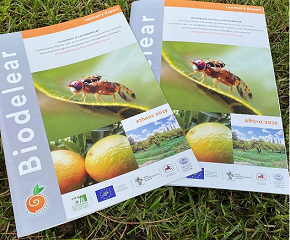1. Implementation in real scale of an innovative, patented, environment friendly and low cost food attractant (Biodelear) for the control of med fly.
The project aims to develop and implement the innovative attractant Biodelear for the control of the med fly in using the mass trapping technique.
The med flies insects belonging in the Tephritidae family, which infest cultivations of fruit trees of large economical importance, cause large damages on fruits and have a large economical effect on the agricultural production. To accomplish control of this pest in conventional agriculture, insecticides and relevant plant-protection products are used, which however have serious disadvantages, such as development of insect resistance against these agents, harmful effects on the environment by means of decreasing the biological diversity by creating imbalances in the soil, and therefore can make a plant more attractive to insects' pest.
Five kinds of treatment are used alone or in combination to eradicate the med fly.
a. Cover Bait Spray Application -The spray contains minimal amounts of an insecticide and protein/sugar bait attracts the flies.
b. Sterile Insect Technique (SIT) - In the SIT, Med flies are reared in large quantities, sterilized with small amount of irradiation, and released into areas where they mate with wild Med flies. Such mattings do not produce offspring. Eventually the wild population is eliminated through attrition. SIT is most effective against low-level med fly populations where a high proportion of sterile to wild flies can be achieved to ensure success. Initial applications of insecticide bait spray and male annihilation are sometimes necessary to bring local populations down to low densities.
c. Insecticide Application to soil under Host Trees- These products will kill some larvae as they enter the soil to pupate and most of the adults as they later emerge. The preferred and most popular eradication strategy is an integrated approach combining all three treatments, with emphasis on the use of SIT.
d. Biological Control - Newly emerged flies need up to 24 hours for their wings to harden before they can fly, so are prone to predation on the soil surface by birds, ants, bugs and earwigs. One of the most used biological control is to cultivate parasitic wasps and released them in the orchards in order to reduce the med fly insects.
e. Mass trapping Control - The mass trapping technique is used for the implication of the control of the med fly for the minimizing the use of insecticides or the complete absence of the insecticides. From the above methods, the most widely used is the Cover Spray Application (a).
The innovative attractant Biodelear is produced during the known Maillard reaction between urea and reducing sugars such as fructose, under specific conditions. The Maillard reaction, a non-enzymatic reaction between amino acids and reducing sugars, has been extensively studied in the thermal treatment of foodstuffs, during which browning effects are caused due to the formation of various aromatic compounds along with amorphous nitrogen-containing polymers [melanoidins]. Melanoidins are nitrogen containing, amorphous polymeric substances [i.e. with no regular structure and no specific molecular weight], having an intense brown colour, which are frequently exploited in food technology. In foodstuff preparation, melanoidins and aromatic compounds are formed, thus by oxidation procedures simple aromatic compounds of low molecular weight are formed, which have organoleptic properties.
This innovative attractant is friendly to the environment and to humans because its preparation is based on food processing techniques as the examples present in literature of similar products of being food additives to ruminants
The handling of the innovative attractant is very easy and the farmers would not have any problem of using it since it is no toxic to humans and to the environment and attracts selectively females med fly and virtually none of the non-targeted insects.
2. Elimination of insecticides use, which are toxic to humans and to the environment, decreases biological diversity by creating imbalances in soil, and make a plant more attractive to insects' pest.
The elimination of insecticides use will be beneficial in a multiple way to humans and to environment and that especially is expected with the application of the innovative attractant Biodelear in the mass trapping technique.
The insecticides are responsible for the decrease in biological diversity in the ecosystem and as a consequence make a plant more attractive to insect’ s pests the insecticides are also responsible for their toxic effects to humans and to the environment.
The biological diversity in the ecosystem such as in the soil and in the canopy of the citrus orchards will be evaluated when the conventional way (use of insecticides by the cover spray application) used for the protection of the citrus orchards from the med fly insects.
The use of the mass trapping technique with the innovative attractant Biodelear in the citrus orchards will be assessed for the restoration of the ecosystem from the use by the conventional way (use of insecticides by the cover spray application) of protection from the med fly insects.
To render Mediterranean farming less dependent on pesticides-conformation of the EU policy: enhanced biological diversity (92/43 EEC) and Elimination of the residue levels of pesticides in or food and feed of plant and animal 2005/396/EC.
3. Development of a sound, integrated and environmental sustainable technology to address med flies in Mediterranean region, using as example the cultivation of citrus.
The aim of the project is to develop a sound an integrated sustainable technology to address med flies in Mediterranean region using as example the cultivation of the citrus fruits through an Integrated Pest Management Strategy.
4. In our project the maximum quantity of the 12 ha citrus orchards would be used and the amount of reduction of the insecticides would be of 100%.
The project will take place in the inland of Chios in 12 ha of citrus orchards without any use of insecticides.






